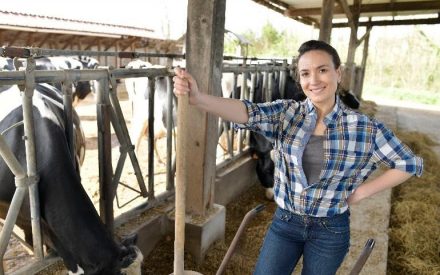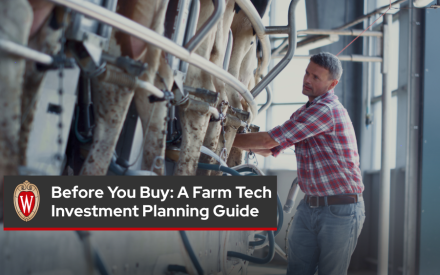
Advanced AI systems hold the potential to reshape how farmers and other agricultural professionals work.
Artificial intelligence (AI) is making its way onto farms and into agricultural businesses across Wisconsin, and a comprehensive new review published in IEEE Transactions on Automation Science and Engineering reveals that these technologies offer capabilities far beyond simple question-answering.
The research article, led by Ranjan Sapkota, a Ph.D. student and research assistant at Cornell University’s Department of Biological and Environmental Engineering, documents how AI systems known as Multi-Modal Large Language Models (MM-LLMs) are transforming farming practices worldwide. Sapkota, who previously conducted research at Washington State University, organized an international team of researchers, including University of Wisconsin–Madison Professor John Shutske, to produce this comprehensive review. The research team reviewed over 200 studies, many of which describe use cases and examples of AI applications in agriculture.
More Than Just a Smart Search Engine
While many people think of AI chatbots as sophisticated question-answering tools, the research shows these systems can do much more. MM-LLMs can analyze drone and satellite images, process sensor data from farm machinery, interpret data from devices worn by animals, generate highly targeted recommendations, and even help control farm equipment via human voice commands.
“The AI systems that we can now access on our phones represent a huge shift in how we can approach challenges on farms of all sizes and types,” explains Shutske. “They’re not just tools that provide information. When used with care, they can help us troubleshoot and solve problems, analyze complex data, and support better decision-making. But, we must be informed and cautious in their use.”
These new systems can process multiple types of information simultaneously. Multi-modal means that software can process text, pictures, voice, weather data, and sensor readings to provide producers with comprehensive insights tailored to specific farming situations.
Powerful Applications Across Crop Production
The research review identifies several game-changing applications for crop agriculture:
Disease and Pest Detection
MM-LLMs can analyze images of crops, weeds, insects, and plant disease and pest symptoms, with rapidly improving accuracy. In some cases, their performance has achieved high accuracy. In some studies, the advice they provide exceeds that of human advisors in terms of clarity and timeliness. These models can then provide tailored treatment recommendations, drawing on vast databases of agricultural research-based information.
Precision Management
AI systems can interpret soil sensor, weather station, and satellite imagery data to recommend optimal planting dates, irrigation schedules, and fertilizer applications. Studies cited in the paper show economic improvements of nearly 50% compared to traditional methods in specific applications.
Real-Time Advisory Services
Farmers can now get instant, location-specific advice on everything from crop rotation decisions to market timing, with the AI drawing from scientific literature, local weather and market conditions, and historical data.
Automated Documentation
Multi-modal LLMs can quickly generate reports, maintain records, and translate complex technical information into plain language, often saving hours of administrative work. Right now, these capabilities are available, but over time, they will improve in reliability and accuracy.
Supporting Agricultural Advisors and Extension Staff
The summary of the research article reminds us that MM-LLMs are not designed to replace agricultural professionals. Instead, they have great potential to amplify their capabilities. For agricultural service providers, this can improve their job satisfaction, especially if they can offload specific tasks that are easily automated. That said, the review does flag the potential for displacement in some functions, which really suggests the need for continued education on the potential of these new tools to leverage time and resources.
For Extension educators, crop consultants, agronomists, veterinarians, and other technical advisors, these tools offer several advantages:
- Enhanced Research Capacity: AI systems can analyze research findings almost instantly, identify relevant studies, and help advisors stay current with the latest agricultural science across multiple disciplines.
- Improved Client Service: Advisors can use MM-LLMs to generate customized recommendations faster, create educational materials more efficiently, and reach more producers with advice that is highly targeted and responsive to local conditions.
- Multilingual Communication: For agricultural service professionals who work with producers from other countries or cultures and speak different languages, these systems can provide real-time translation, improving two-way communication. Like many of the applications described in the review, the use of AI to enhance person-to-person communication and relationships is still in its relative infancy. It will only get better in the future.
- Freed-Up Time for Relationships: By handling routine data analysis and administrative tasks, AI tools allow advisors in agriculture to spend more time building relationships, conducting on-farm visits, and addressing complex challenges that require human judgment. “The goal of most well-designed technology isn’t to replace the expertise of experts like Extension professionals or crop consultants,” Shutske emphasizes. “Rather, these tools can handle time-consuming tasks like data processing and information synthesis, freeing professionals to focus on what they do best. Many of us were drawn to work in ag because we love to interact with farmers and help them tackle issues that require human insight and local knowledge.”
Beyond Crop Production
While this comprehensive research review focuses primarily on crop and plant agriculture, the researchers note that MM-LLMs are also being explored for livestock management applications. Research suggests the potential to analyze and act upon information gleaned from video and other sensor data for livestock management.
Understanding the Challenges
The research team is quite candid and cautious about the current limitations of using AI to support agricultural work. Data availability and quality are enormous challenges. It can be tough to know what’s out there and how to make actionable use of the massive amount of information. This is particularly concerning for smaller farms, specialized farming operations, or areas of the state where affordable broadband access is limited.
Within the industries and facilities that support AI use, these systems require substantial computing power and must be continuously updated with new research and local information. In recent times, the water and energy use impacts of AI data centers that tech companies are building across the country, including in rural farming areas, have come to the forefront.
Privacy and security concerns also need attention, as these systems may be called upon to process sensitive farm data. The paper calls for transparent frameworks to ensure that AI recommendations can be trusted and that farmers’ information is fully protected and their privacy needs fully met.
There’s also the question of workforce impact. “As AI handles more routine tasks, the agricultural industry will need to help workers develop tech literacy skills and adapt to changing roles,” notes Shutske. “We need to think carefully about the educational needs connected to data-driven agriculture and how we can best prepare people for some of the exciting and evolving future agricultural jobs. Shutske also notes, “My colleagues and I who work with farmers and ag industry leaders nationwide often talk about how new technologies might make farm and agricultural careers more appealing and exciting for the next generation and open up even more job opportunities in our rural communities.”
Looking Forward
The team that worked on this paper outlined a roadmap for the future. Some of the ideas include:
- Better integration with sensors and farm equipment
- More sophisticated predictive capabilities for weather, pests, and market conditions
- Specialized models trained specifically on regional and local agricultural data
- Improved transparency so users can understand how AI systems arrive at their recommendations
Try It Yourself
One of the most exciting aspects of this technology is its accessibility. Private companies and universities are developing several widely used MM-LLM tools for agricultural applications, and they are available to try. Farmers, consultants, and agricultural professionals can experiment with these tools now on their computers or smartphones.
Try asking questions about your crops, uploading photos of plant problems, or requesting help with farm planning. While you must always verify all recommendations with trusted experts, exploring these tools offers valuable insight into how they work and what they might offer your operation. This will become increasingly important as these tools grow in their capabilities in the very near future.
The Bottom Line
Multi-Modal Large Language Models represent a significant advancement for agriculture. They are not viewed as a replacement for human expertise, but as a powerful tool to support better decision-making, improve efficiency, and help farms of all sizes access cutting-edge agricultural science.
As Sapkota, Shutske, and their co-authors conclude, MM-LLMs are poised to transform agricultural productivity. The team emphasizes the potential of AI applications but warns of the need for continued critical thinking, as well as of issues related to responsible and appropriate deployment.
Whether you’re a farmer, advisor, or agricultural professional, now is the time to explore what these technologies can do. The farms of the future are being shaped today. Understanding these tools will be key to staying competitive and sustainable.
Published: Nov. 17, 2025
Note: Article drafted, edited, and finalized by John Shutske
AI was used to develop the original paper outline and to double-check and verify the accuracy of all statements for alignment and consistency with the original research article.


 Building a Positive Farm Business Culture: Perceptions of Health and Safety among Latin/Hispanic Dairy Workers
Building a Positive Farm Business Culture: Perceptions of Health and Safety among Latin/Hispanic Dairy Workers A culture of ‘farm safety’ starts with a well-written policy
A culture of ‘farm safety’ starts with a well-written policy The Farm Business Culture
The Farm Business Culture Before You Buy: A Farm Tech Investment Planning Guide
Before You Buy: A Farm Tech Investment Planning Guide


